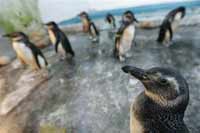Antarctic penguins invade sunny beaches of Brazil
Penguins that were previously spotted in Brazil’s southern waters can now be seen in the north-east of the Latin American nation, RIA Novosti reports.

Holiday-makers have spotted dozens of these Antarctic birds in subequatorial waters of north-eastern Brazilian states of Bahia and Sergipe. Biologists say that it was the record northward movement of penguins.
Click here to see the video of penguins on Brazilian beaches.
Scientists believe that global warming can be the most probable explanation to this unusual phenomenon. Antarctic ice continues to melt, whereas the cold-water Falkland Current along the Atlantic coast of South America intensifies.
The birds inhabiting Antarctica and Patagonia have to swim too far searching for food at sea mainly because of excessive fishing. They find themselves trapped in strong ocean currents that eventually carry them to sunny beaches of Brazil.
The Brazilian Institute of Environment and Renewable Natural Resources (IBAMA) said that the invasion of penguins in Brazil had resulted in the appearance of illegal businesses to sell the exotic birds. The price of one baby penguin may reach up to 500 Brazilian reals ($318) on the black market.
Many local residents attempt to take penguins home and tame them, although specialists recommend not to feed or wash the birds at home. They recommend to ask for professional aid for the majority of penguins reach Brazilian beaches exhausted, hungry and extremely weak, having overcome the distance of up to 5,000 kilometers in cold waters.
Specialists say that hundreds of dead baby penguins have been beached in Brazil over the recent two months. The birds die because of water pollution, ecologists believe.
The word Penguin is thought by some to derive from the Welsh words pen (head) and gwyn (white), applied to the Great Auk which had white spots in front of its eyes (although its head was black); or from an island off Newfoundland known as Pengwyn, due to its having a large white rock. (In the latter case, the name may also have come from Breton.) This theory is supported by the fact that penguins look remarkably like Great Auks in general shape.
It is also possible that penguin comes from the Latin pinguis, “fat”. This is supported by the fact that the corresponding words in most other languages (e.g., French pingouin, German Pinguin) have ‘i’ instead of ‘e’ as the first vowel. However, a Welsh ‘i’ is often sound-shifted to an ‘e’ in the English language.’
Another theory states that the word is an alteration of “pen-wing”, with reference to the rudimentary wings of both Great Auks and penguins, but there is no evidence to support this.
What may be a King Penguin but certainly is a member of the Spheniscidae appears on a 1599 map at the Strait of Magellan with the caption "Pinguyn". The map's features are labeled in Latin, such as Fretum Magellanicum ("Strait of Magellan"). In addition, there is ample evidence that the Latin term anser magellanicus ("Goose of Magellan" or "Magellanic Goose") was the usual term for penguins in the scholarly literature of that time. If the English word was derived from Latin – e.g. avis pinguis ("fat bird") or pinguinus ("the fat one" – it must have originated considerably earlier than 1600.
In a final twist to the story, the term "Magellanic Goose" (today usually "Magellan Goose") in our time has come to denote an actual anseriform, namely a Chloephaga sheldgoose.
Subscribe to Pravda.Ru Telegram channel, Facebook, RSS!




